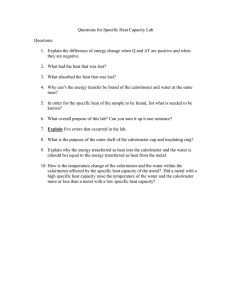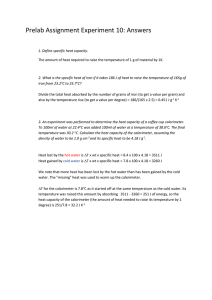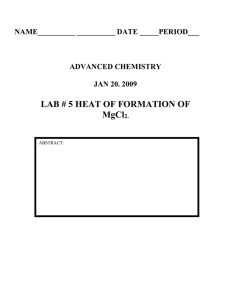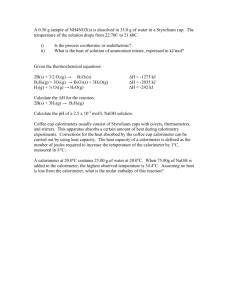TPM Calibration Methods
advertisement
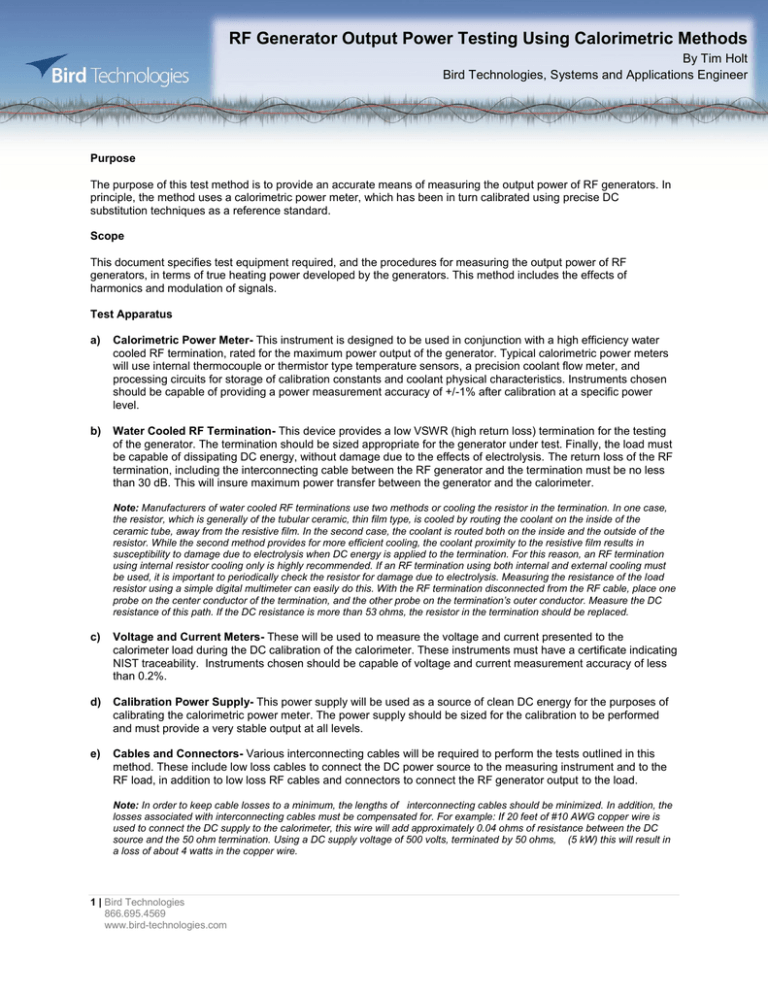
RF Generator Output Power Testing Using Calorimetric Methods By Tim Holt Bird Technologies, Systems and Applications Engineer Purpose The purpose of this test method is to provide an accurate means of measuring the output power of RF generators. In principle, the method uses a calorimetric power meter, which has been in turn calibrated using precise DC substitution techniques as a reference standard. Scope This document specifies test equipment required, and the procedures for measuring the output power of RF generators, in terms of true heating power developed by the generators. This method includes the effects of harmonics and modulation of signals. Test Apparatus a) Calorimetric Power Meter- This instrument is designed to be used in conjunction with a high efficiency water cooled RF termination, rated for the maximum power output of the generator. Typical calorimetric power meters will use internal thermocouple or thermistor type temperature sensors, a precision coolant flow meter, and processing circuits for storage of calibration constants and coolant physical characteristics. Instruments chosen should be capable of providing a power measurement accuracy of +/-1% after calibration at a specific power level. b) Water Cooled RF Termination- This device provides a low VSWR (high return loss) termination for the testing of the generator. The termination should be sized appropriate for the generator under test. Finally, the load must be capable of dissipating DC energy, without damage due to the effects of electrolysis. The return loss of the RF termination, including the interconnecting cable between the RF generator and the termination must be no less than 30 dB. This will insure maximum power transfer between the generator and the calorimeter. Note: Manufacturers of water cooled RF terminations use two methods or cooling the resistor in the termination. In one case, the resistor, which is generally of the tubular ceramic, thin film type, is cooled by routing the coolant on the inside of the ceramic tube, away from the resistive film. In the second case, the coolant is routed both on the inside and the outside of the resistor. While the second method provides for more efficient cooling, the coolant proximity to the resistive film results in susceptibility to damage due to electrolysis when DC energy is applied to the termination. For this reason, an RF termination using internal resistor cooling only is highly recommended. If an RF termination using both internal and external cooling must be used, it is important to periodically check the resistor for damage due to electrolysis. Measuring the resistance of the load resistor using a simple digital multimeter can easily do this. With the RF termination disconnected from the RF cable, place one probe on the center conductor of the termination, and the other probe on the termination’s outer conductor. Measure the DC resistance of this path. If the DC resistance is more than 53 ohms, the resistor in the termination should be replaced. c) Voltage and Current Meters- These will be used to measure the voltage and current presented to the calorimeter load during the DC calibration of the calorimeter. These instruments must have a certificate indicating NIST traceability. Instruments chosen should be capable of voltage and current measurement accuracy of less than 0.2%. d) Calibration Power Supply- This power supply will be used as a source of clean DC energy for the purposes of calibrating the calorimetric power meter. The power supply should be sized for the calibration to be performed and must provide a very stable output at all levels. e) Cables and Connectors- Various interconnecting cables will be required to perform the tests outlined in this method. These include low loss cables to connect the DC power source to the measuring instrument and to the RF load, in addition to low loss RF cables and connectors to connect the RF generator output to the load. Note: In order to keep cable losses to a minimum, the lengths of interconnecting cables should be minimized. In addition, the losses associated with interconnecting cables must be compensated for. For example: If 20 feet of #10 AWG copper wire is used to connect the DC supply to the calorimeter, this wire will add approximately 0.04 ohms of resistance between the DC source and the 50 ohm termination. Using a DC supply voltage of 500 volts, terminated by 50 ohms, (5 kW) this will result in a loss of about 4 watts in the copper wire. 1 | Bird Technologies 866.695.4569 www.bird-technologies.com RF Generator Output Power Testing Using Calorimetric Methods By Tim Holt Bird Technologies, Systems and Applications Engineer Similarly, RF cable losses must be compensated. For example, suppose that an RF generator, operating at 13.56 MHz and developing 3kW is connected to the calorimeter through a 20-foot length of RG-217/U coaxial cable. RG-217/U coaxial cable has a loss specification of 0.41 dB per 100 feet of cable at 13.56 MHz. Since we are using 20 feet of cable, the loss would be 0.41/5, or 0.082 dB. If the RF generator is developing 3 kW, this means that 2.944 kW would appear at the calorimeter due to the cable loss. The reading obtained by the calorimeter should be adjusted according to the cable loss value. Methodology Calorimetric power meters provide excellent reference standards for the measurement of radio frequency energy in that they are capable of measuring the true heating power of a waveform, including any harmonic or nonharmonically related frequency components. The technique employed for this test is to first calibrate the calorimetric power meter with DC energy, which can be very precisely determined. Two digital multimeters (Fluke 87 or equivalent) are used to determine the actual DC power applied to the calorimeter. Once the DC calibration has been performed at a particular power level, the output of the RF generator under test is connected to the calorimeter, and the output power of the generator is measured. The basic steps involved in the use of this system are as follows: 1) Calibrate the Calorimeter- The calorimeter is calibrated with the stable DC power supply, using the two digital multimeters to read the voltage and current applied to the calorimeter’s RF load. Connections- Connect the DC power supply; the digital multimeters, and the RF load according to figure 1. Connections between the multimeters, the DC power supply, and the RF load must be made using high quality low loss cable, using high quality corrosion free cable terminations. The calorimeter must also be equipped with a coolant system. Most calorimeter systems use either a tap water coolant system, or a recirculating system of some type. Best results may be obtained through the use of a selfcontained heat exchanger and coolant recirculating system. When all electrical and coolant connections have been made to the calorimeter, apply mains power to the calorimeter system, and allow 1 hour for stabilization. Note: In order to prevent the possibility of ground loops between the RF generator and the calorimeter system, be sure to operate the calorimeter and the RF generator on the same AC supply. Load Differential Temperature Most calorimeter systems will yield optimum performance when certain operating parameters relating to the differential temperature across the RF load, and the flow rate are maintained. In most cases, a differential temperature of 2 degrees Centigrade represents a good beginning point. The coolant flow rate may then be set to provide for this differential temperature. The following formula may be used to arrive at the correct coolant flow rate. Power (watts) = 262.4 X T (C) X Flow (GPM) 2 | Bird Technologies 866.695.4569 www.bird-technologies.com RF Generator Output Power Testing Using Calorimetric Methods By Tim Holt Bird Technologies, Systems and Applications Engineer Solving for flow rate yields: Flow (GPM) = (Power (watts)/262.4) / T (C) Another consideration in the setting of the coolant flow rate is the minimum flow rate specification for particular RF loads. Consult the RF load operating manual for this information. Coolants- In most cases, the coolant used in calorimetric power measurement systems is pure distilled water. In this case, most modern calorimeters will automatically correct for changes to the coolant physical characteristics (specific heat, specific gravity) as the coolant temperature changes. If coolant other than pure water is used, and the calorimeter chosen will not automatically compensate for changes to the coolant, the power readings obtained must be adjusted for the effects of the coolant changes. Consult the calorimeter operating manual for specific details. Calorimeter Calibration- Following the calorimeter warm-up, the device is ready for calibration. With the calorimeter operating with the appropriate flow rate, apply DC power to the RF load, according to the voltage and current readings obtained with the two digital multimeters. Multiply the voltage by the current to obtain the power applied to the load. Allow fifteen minutes for the calorimeter reading to stabilize. Using the procedure in the calorimeter operating manual set the calorimeter such that the calorimeter reading is exactly the same as that obtained using the voltage and current meters. At this point, add any offsets that are associated with interconnecting cable losses, as outlined in the notes above. The calorimeter is now calibrated at this specific power level. Note: If a new power level is chosen, this process will need to be repeated, in order to compensate for instrumentation linearity effects of the calorimeter. 2.) RF Generator Testing- With the calorimeter calibrated at a particular power level, it is now possible to test the RF Generator power output at this level. Connections- Connect the RF Generator output to the RF Load according to figure 2. Cables and connectors between the RF Generator output and the RF Load must of a high quality, low loss type. As outlined above, some power will be lost in the cables between the generator and the load. These losses should be added as offsets to the calorimeter reading, in order to obtain the total power output of the generator. Losses will be based upon cable length, cable type, and operating frequency. See SEMI E-114 Test Method for details on cable loss compensation. Testing- With the connections made according to figure 2, apply mains power to the RF Generator, and allow fifteen minutes for stabilization. The power reading obtained on the calorimeter will represent the total power output of the generator, including harmonics. Begin generator testing at a power level, which represents 10% of the maximum output power of the generator. Repeat the test at generator power levels of 40% of maximum, 70% of maximum, and maximum power. Tests should also be conducted corresponding to each range on the generator power output meter. Note: The calorimeter power meter must be calibrated to the DC standard at each power level used. 3 | Bird Technologies 866.695.4569 www.bird-technologies.com RF Generator Output Power Testing Using Calorimetric Methods By Tim Holt Bird Technologies, Systems and Applications Engineer 4 | Bird Technologies 866.695.4569 www.bird-technologies.com


